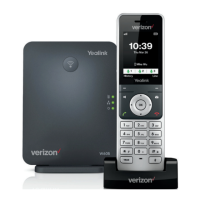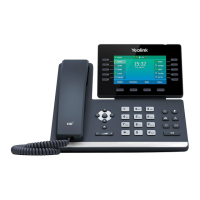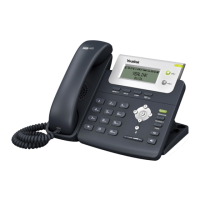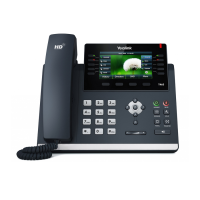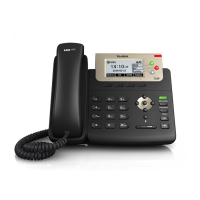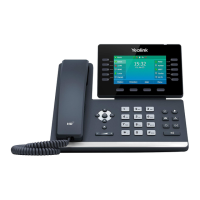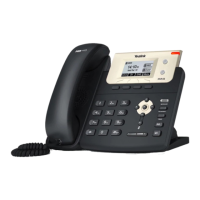Do you have a question about the Yealink One Talk W78B and is the answer not in the manual?
Details the physical components and indicators of the base station and handset for easy identification and understanding.
Explains the menu structure and navigation within the W78HV handset, guiding users through its features.
Outlines the primary menu items available on the W78HV handset, such as Status, Intercom, Voice Mail, and Settings.
Describes the procedure for accessing the main menu on the W78HV handset to view available features.
Explains how to navigate submenus within the handset, allowing access to specific functions and settings.
Describes the components of the idle screen, such as signal strength, battery status, handset name, and soft keys.
Explains various status icons displayed on the phone screen, indicating features like Bluetooth, call recording, and missed calls.
Illustrates and describes icons used on the call screen to convey call status, audio modes, and call states like hold or mute.
Guides users on selecting different input modes for entering text and characters on the handset's keypad.
Instructs on how to activate the registration mode on the base station to prepare for handset pairing.
Details the process of pairing a new W78HV handset with the base station for the first time.
Explains how to register an existing handset to a different base station, useful for changing configurations.
Describes how to manually choose a base station for the handset to connect to, or select the best available.
Provides instructions on how to assign a custom name to a registered base station for easier identification.
Outlines the steps to remove a handset's registration from a base station, typically when replacing hardware.
Guides users on how to select which line the handset uses for outgoing calls when multiple lines are assigned.
Covers the fundamental process of initiating both internal and external calls using the handset.
Explains how to make calls between handsets registered to the same base station, often used for intercom purposes.
Details how to configure the handset to automatically answer internal calls based on preferences like audible alerts.
Provides specific steps for making an internal call to a single handset or all registered handsets.
Instructs on how to make calls to numbers outside the local system, utilizing the public telephone network.
Explains how to manage multiple calls simultaneously, including placing new calls while an existing one is active.
Describes how to redial or call contacts directly from the recorded list of recent calls.
Details how to initiate calls to contacts stored in the handset's directory.
Guides on making calls to contacts stored in a shared directory accessible by multiple users.
Explains how to assign frequently used numbers to specific keypad keys for quick dialing.
Provides steps to modify or update a contact assigned to a speed dial key.
Details how to remove a contact from a speed dial assignment.
Describes the action of dialing a number by simply pressing and holding its assigned speed dial key.
Explains how to access the list of recently dialed numbers and redial a specific entry.
Details the quick method to redial the most recently made call by pressing a specific key combination.
Guides on saving numbers from the redial list into the handset's local directory for future use.
Explains how to remove individual entries from the redial list.
Provides instructions to clear the entire redial list at once.
Covers the feature to make calls while hiding the caller's identity and number from the recipient.
Details how to specify which phone lines the handset should receive incoming calls from.
Explains the basic procedures for answering an incoming call, either manually or automatically.
Describes how to handle a second incoming call when already engaged in an active call, utilizing call waiting.
Details the setting that allows incoming calls to be answered automatically when the handset is picked up from the charger.
Explains how to turn off the call waiting feature, which will automatically reject new calls during an active call.
Guides on selecting the audio output mode (receiver, speakerphone, or headset) during a call.
Covers options to silence or reject incoming calls instead of answering them.
Details how to block calls from callers who have hidden their identity, preventing the phone from ringing.
Covers enabling the DND feature to automatically reject all incoming calls when the user does not wish to be disturbed.
Describes the action of terminating an active call on the handset.
Explains how to temporarily disable or re-enable the microphone during a call.
Details the process of placing calls on hold and retrieving them later.
Guides on setting up call forwarding rules to redirect incoming calls to another number based on different conditions.
Covers methods for transferring calls to other contacts, including direct and consultative transfers.
Details how to set up and manage conference calls involving multiple participants.
Provides instructions for initiating a conference call with two or more contacts through the network.
Explains how to add new participants to an ongoing conference call.
Describes how individual participants can place themselves on hold during a conference call.
Details the procedure for terminating an active conference call.
Explains the functionality of parking a call (placing it on hold) and retrieving it later from the same or another phone.
Guides users on setting up a security code to access the voicemail system.
Describes how to assign a dedicated key for quick access to voicemail messages for a particular line.
Explains how to record and leave a voice message for another user.
Details how to access and listen to received voicemail messages on the handset.
Covers managing contacts stored locally on the handset, including adding, viewing, editing, and deleting.
Provides instructions for saving new contact information into the handset's local directory.
Explains how to browse and view the contacts stored in the local directory.
Guides on modifying existing contact information in the local directory.
Details how to remove individual contacts or all entries from the local directory.
Specific steps to remove a single contact entry from the local directory.
Instructions for clearing all contact entries from the local directory simultaneously.
Explains how to use search criteria to quickly find contacts within the local directory.
Guides on adding numbers to the blocklist to prevent unwanted callers from reaching the handset.
Details how to review the list of blocked numbers.
Explains how to modify details of contacts already present in the blocklist.
Covers how to remove individual or all entries from the blocklist.
Specific steps to remove a single contact from the blocklist.
Details how to search for contacts within a corporate or remote directory.
Explains how to browse the list of contacts available in the remote phone book.
Guides on copying contacts from a remote directory to the local directory for easier access.
Describes how to manually refresh or update the contact list in the remote phone book.
Explains the meaning of the icons used in the call history to categorize calls as received, missed, or placed.
Details how to access and review past call records, including caller information and duration.
Guides on adding call history entries to the local directory for quick dialing and identification.
Explains how to add a number from the call history directly to the blocklist to prevent future calls.
Details the process of removing a single entry from the call history.
Provides instructions to clear the entire call history list at once.
Explains the methods for powering on the W78HV handset, either by inserting the battery or placing it in the cradle.
Describes how to manually power down the W78HV handset when not in use.
Guides on modifying the base station's Personal Identification Number for security and access control.
Details how to customize the idle screen background by selecting a new wallpaper image.
Explains how to activate and configure the screen saver feature to protect the phone's display.
Guides on adjusting the backlight brightness for the handset's screen, both when charging and not.
Details how to enable or disable the illumination of the keypad keys when pressed.
Provides instructions on selecting the preferred language for the handset's interface.
Guides on manually configuring the handset's current time and date settings.
Explains how to select the preferred display format for time (12/24 hour) and date (day, month, year).
Lists the default shortcuts available on the handset for quick access to features.
Details how to reassign functions to shortcut keys to personalize handset operations.
Explains how to manually lock the handset's keypad to prevent accidental usage.
Provides instructions on how to unlock the handset's keypad after it has been locked.
Guides on configuring the phone's lock settings, including automatic locking and lock types.
Details the procedure for manually locking the phone at any time.
Explains how to unlock the phone using a PIN after it has been locked.
Provides instructions for changing the default unlock PIN for enhanced security.
Describes how to locate a misplaced handset by activating a ringing signal from the base station.
Guides on personalizing the name of the handset for easier identification, especially with multiple units.
Explains how to enable Eco Mode+ to reduce transmission power and radio waves when the phone is idle.
Details how to use Eco Mode to reduce transmission power during calls, affecting radio coverage.
Covers activating silent mode to prevent the handset from ringing for incoming calls.
Details how to activate silent mode, preventing the handset from ringing for incoming calls.
Explains how to deactivate silent mode to restore normal ringing for incoming calls.
Guides on controlling the volume levels for ringer, media, and call audio on the handset.
Covers selecting and assigning distinct ring tones for incoming calls.
Explains how to select unique ring tones for internal calls to distinguish callers.
Details how to choose specific ring tones for external calls to identify callers.
Guides on enabling silent mode specifically when the handset is in the charging cradle.
Explains the options for handset vibration during incoming calls, including ring and vibrate combinations.
Details how to turn off the noise cancellation feature to improve speech intelligibility in noisy environments.
Provides instructions on activating or deactivating the Bluetooth feature on the handset.
Guides on finding and connecting a Bluetooth headset to the W78HV handset.
Explains how to view, connect, disconnect, or delete previously paired Bluetooth headsets.
Details how to change the displayed name of the handset for easier recognition, especially when connected via Bluetooth.
Guides on checking and understanding warning messages displayed on the phone's status screen.
Explains how to reboot the base station to resolve operational issues or refresh settings.
Details the process of restoring the base station to its original factory default settings.
Provides instructions on how to reboot the W78HV handset to resolve minor software glitches.
Guides on restoring the handset's settings to factory defaults, excluding specific data like contacts.
Lists available input modes and the characters associated with each mode for text entry.
Provides information on where to find additional help, FAQs, and product documentation.
Contains crucial safety advice and guidelines for connecting and operating the phone, including electrical precautions.
Advises on the proper disposal of electronic waste according to environmental regulations.
States that product specifications and information are subject to change without notice and are provided without warranty.
Crucial information regarding 911 calls, including location accuracy and feature limitations during emergencies.
States that the product complies with essential requirements of CE and FCC regulations.
Notifies users about the device's compliance with R&TTE Directive for radio equipment.
Outlines compliance with FCC Part 15 rules regarding radio frequency interference.
Explains the device's compliance with Class B limits for digital devices to minimize interference in residential settings.
Lists essential safety notices and instructions for installation and usage to prevent injury or damage.
Warns about the hazards of electric current from power and communication cables, posing risks of shock and fire.
Provides a URL for users seeking additional information about the product and services.

